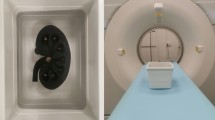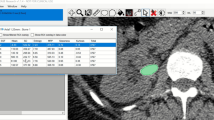Abstract
The lithiasic size is a determining factor in selecting the most suitable treatment, surgical or medical. However, the method for obtaining a reliable lithiasic size is not standardized. Our objetives are to determine the differences between the estimated lithiasic sizes shown by plain radiography test and by computerized axial tomography (CT) scan (using different techniques) in relation to the actual size, and to establish which is the ideal type of imaging for this purpose. We present an in vitro model with lithiasis obtained in cooperation with four centers. Inclusion criteria: lithiasis >0.5 cm, intact, and visible via simple radiography. A sample of 245 lithiases was obtained, with 87 rejected as they did not fulfill the inclusion criteria. Initially the three main actual diameters of each lithiasis were measured with a calibrator, then a plain X-ray and a CT scan were taken of the samples to determine the surface size in cm2 for simple radiography; surface size and volume in cm3 for CT scan, in bone window and soft tissue (Toshiba Aquillion 64, sections of 0.5 mm, 120 Kv, 250 mA). The tomographic area was calculated by employing the formula recommended by the European Association of Urology and scanner software. The actual, radiographic and tomographic measurements were taken by three different researchers who were unaware of the results obtained by the each other. The statistics program IBM SPSS Statistics® 19 was used. Differences were analyzed using the Wilcoxon sign test. The bone window CT scan slightly overestimated the actual lithiasic size (0.12 vs. 0.17 cm3), while in soft tissue window the actual volume was practically doubled (0.12 vs. 0.21 cm3) (p < 0.05). We did not find statistically significant differences in the comparison between actual surface size (0.39 cm2) and bone window CT scan size when using the EAU formula or scanner software (0.36/0.37 cm2). Resulting measurements in soft tissue window tended to significantly overestimate the surface size, although only slightly (0.42/0.44 cm2), whilst the plain radiography underestimated it slightly but significantly (0.37 cm2). CT scan, using the bone window, is the technical methodology with which the greatest in vitro accuracy in which actual lithiasis measurements can be estimated, although the craniocaudal diameter measurement will be overestimated. Using soft tissue window gives an overestimated size.

Similar content being viewed by others
References
Türk C, Knoll T, Petrik A, Sarica K, Straub M, Seitz C (2012) Guidelines on Urolithiasis. Uroweb Available at: http://www.uroweb.org/gls/pdf/20_Urolithiasis_LR%20March%2013%202012.pdf
Integrated Assistential Urolythiasis Process (2012) 1st edn Regional Government of Andalucía (Junta de Andalucía) Department of Health http://www.juntadeandalucia.es/salud/export/sites/csalud/galerias/documentos/p_3_p_3_procesos_asistenciales_integrados/urolitiasis/urolitiasis.pdf
Patel SR, Nakada SY (2011) Quantification of preoperative stone burden for ureteroscopy and shock wave lithotripsy: current state and future recommendations. Urology 78:282–285
Ray AA, Ghiculete PKT, Honey RJ (2010) Limitations to ultrasound in the detection and measurement of urinary tract calculi. Urology 76:295–300
Hyams ES, Bruhn A, Lipkin M et al (2010) Heterogeneity in the reporting of disease characteristics and treatment outcomes in studies evaluating treatments for nephrolithiasis. J Endourol 24:1411–1414
Deters LA, Jumper CM, Steinberg PL, Pais VM Jr (2011) Evaluating the definition of “stone free status” in contemporary urologic literature. Clin Nephrol 76:354–357
Olcott E, Sommer FG, Napel S (1997) Accuracy of detection and measurement of renal calculi: in vitro comparison of three-dimensional spiral CT, X-ray, and nephrotomography. Radiology 204:19–25
Dundee P, Bouchier-Hayes D, Haxhimolla H, Dowling R, Costello A (2006) Renal tract calculi: comparison of stone size on plain X-ray and non contrast spiral CT scan. J Endourol 20:1005–1009
Parsons JK, Lancini V, Shetye K, Regan F, Potter SR, Jarrett TW (2003) Urinary stone size: comparison of abdominal plain X-ray and non contrast CT measurements. J Endourol 17:725–728
Tisdale BE, Siemens DR, Lysack J, Nolan RL, Wilson JW (2007) Correlation of CT scan versus plain radiography for measuring urinary stone dimensions. Can J Urol 14:3489
Narepalem N, Sundaram CP, Boridy IC, Yan Y, Heiken JP, Clayman RV (2002) Comparison of helical computerized tomography and plain radiography for estimating urinary stone size. J Urol 167:1235
Nadler RB, Stern JA, Kimm S, Hoff F, Rademaker AW (2004) Coronal imaging to assess urinary tract stone size. J Urol 172:962–964
Patel SR, Stanton P, Zelinski N, Borman EJ, Pozniak MA, Nakada SY et al (2011) Automated renal stone volume measurement by non contrast computerized tomography is more reproducible than manual linear size measurement. J Urol 186:2275–2279
Bandi G, Meiners RJ, Pickhardt PJ et al (2008) Stone measurement by volumetric three-dimensional computed tomography for predicting outcome after extracorporeal shock wave lithotripsy. BJU Int 103:524
Eisner BH, Kambadakone A, Monga M, Anderson JK, Thoreson AA, Lee H et al (2009) Computerized tomography magnified bone windows are superior to standard soft tissue windows for accurate measurement of stone size: an in vitro and clinical study. J Urol 181:1710–1715
Conflict of interest
The authors declare that they have no conflict of interest.
Author information
Authors and Affiliations
Corresponding author
Rights and permissions
About this article
Cite this article
Argüelles Salido, E., Aguilar García, J., Lozano-Blasco, J.M. et al. Lithiasis size estimation variability depending on image technical methodology. Urolithiasis 41, 517–522 (2013). https://doi.org/10.1007/s00240-013-0597-0
Received:
Accepted:
Published:
Issue Date:
DOI: https://doi.org/10.1007/s00240-013-0597-0




